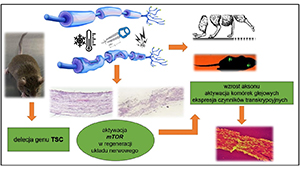Evaluation of the regeneration process of the sciatic nerve of a mouse animal model after application of freezing, crushing or electrocoagulation damage
DOI:
https://doi.org/10.18388/pb.2021_504Abstract
The problem of regeneration of damaged peripheral nerves is an ongoing topic and has long been the subject of intensive research worldwide. This study examined the morphological and functional evaluation of the regeneration process within the damaged sciatic nerve, a mouse animal model. The effect of impaired expression of the TSC-1 gene on the process of nerve regeneration was evaluated, depending on the mode of damage. The research object consisted of 48, 2-month-old male TSC lines. The test group consisted of animals that underwent damage to the sciatic nerve by crushing, freezing and electrocoagulation, while the control group includes mice whose sciatic nerve was not damaged. Behavioral tests were conducted to evaluate the functional return of the limb, after 3,5,7 and 14 days. The first changes in the regeneration process of the damaged neurite are observed as early as day 3 after the injury, while on day 14 after the injury the functional return of the damaged limb was noted.

Published
Issue
Section
License
Copyright (c) 2023 Dariusz Górka , Krzysztof Suszyński , Natalia Białoń, Mikołaj Górka , Michał Trzęsicki, Kacper Zając, Anna Dolińska, Filip Tomsia

This work is licensed under a Creative Commons Attribution 4.0 International License.
All journal contents are distributed under the Creative Commons Attribution-ShareAlike 4.0 International (CC BY-SA 4.0) license. Everybody may use the content following terms: Attribution — You must give appropriate credit, provide a link to the license, and indicate if changes were made, ShareAlike — If you remix, transform, or build upon the material, you must distribute your contributions under the same license as the original. There are no additional restrictions — You may not apply legal terms or technological measures that legally restrict others from doing anything the license permits.
Copyright for all published papers © stays with the authors.
Copyright for the journal: © Polish Biochemical Society.



